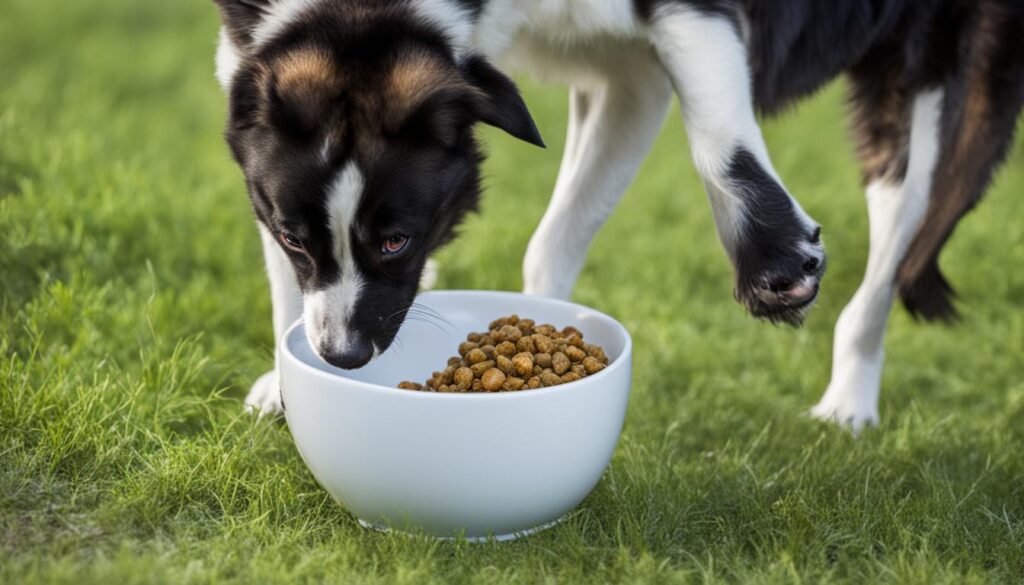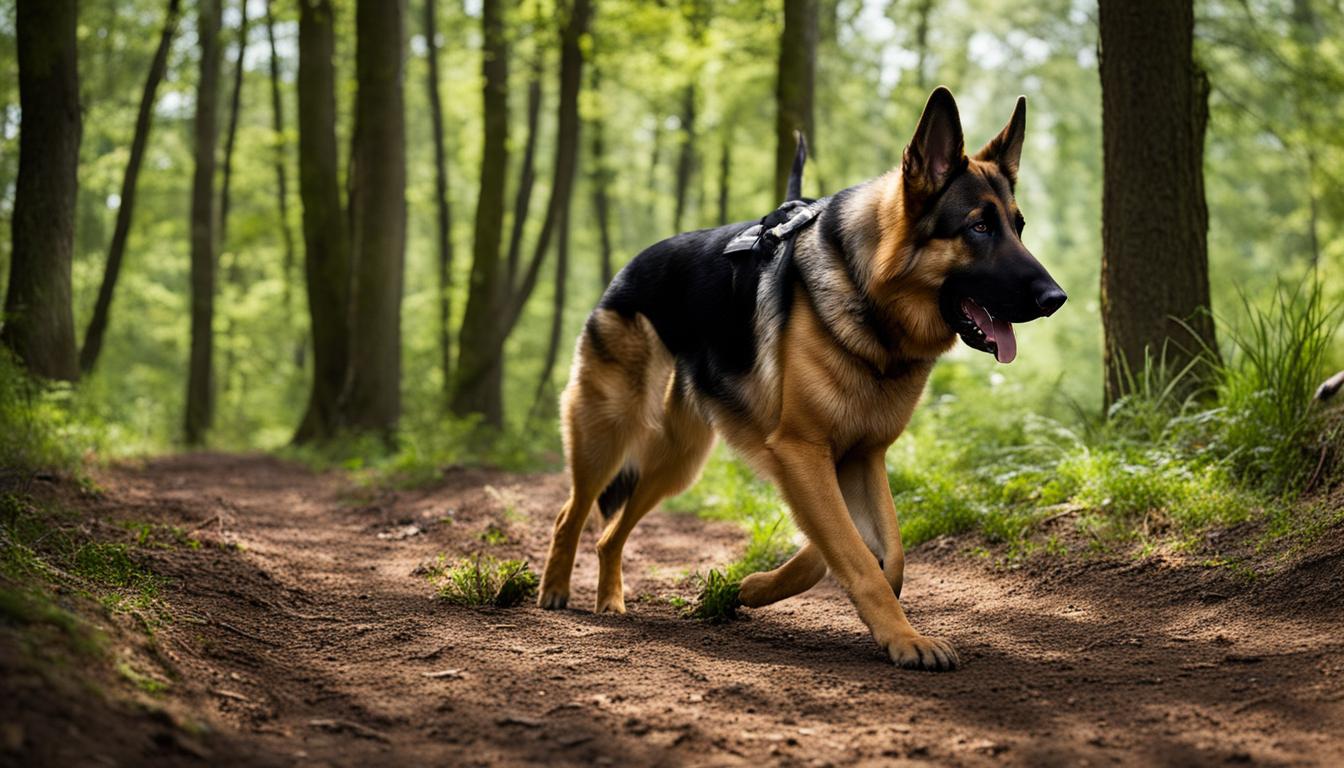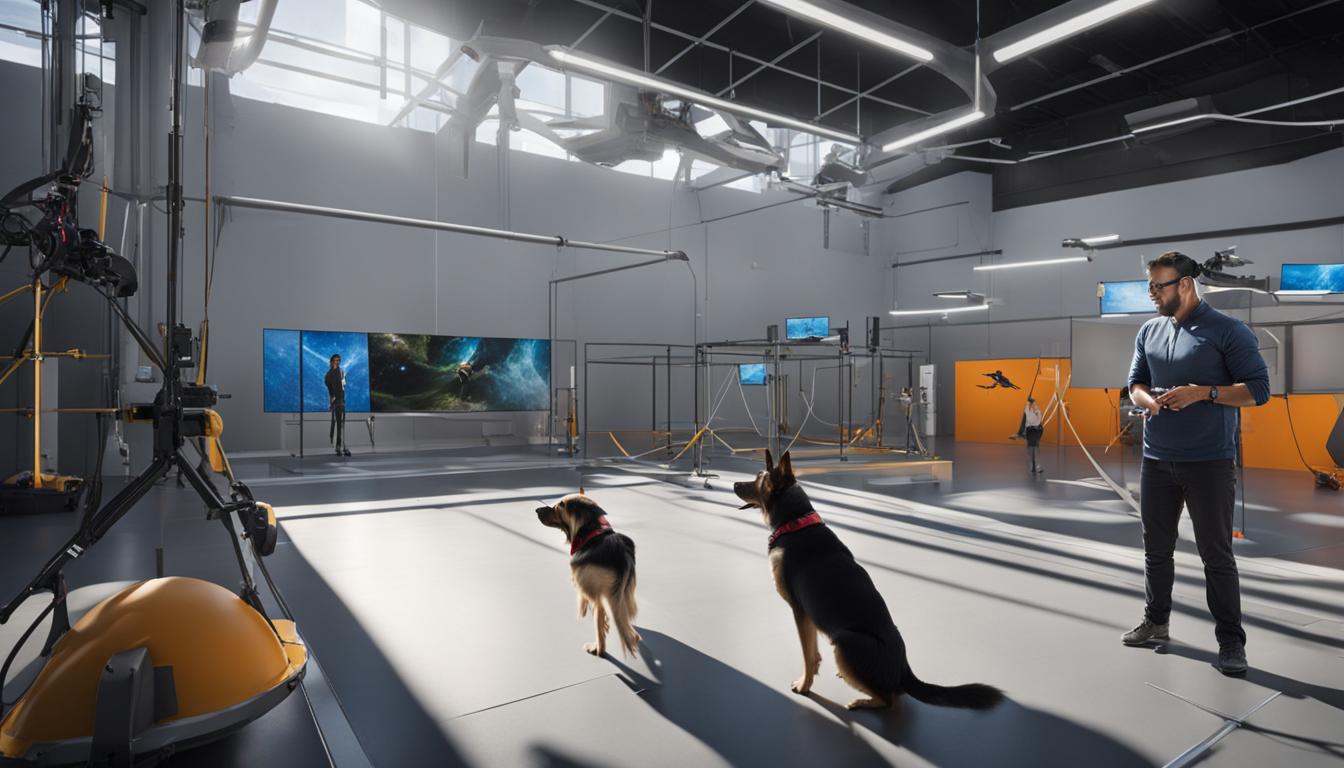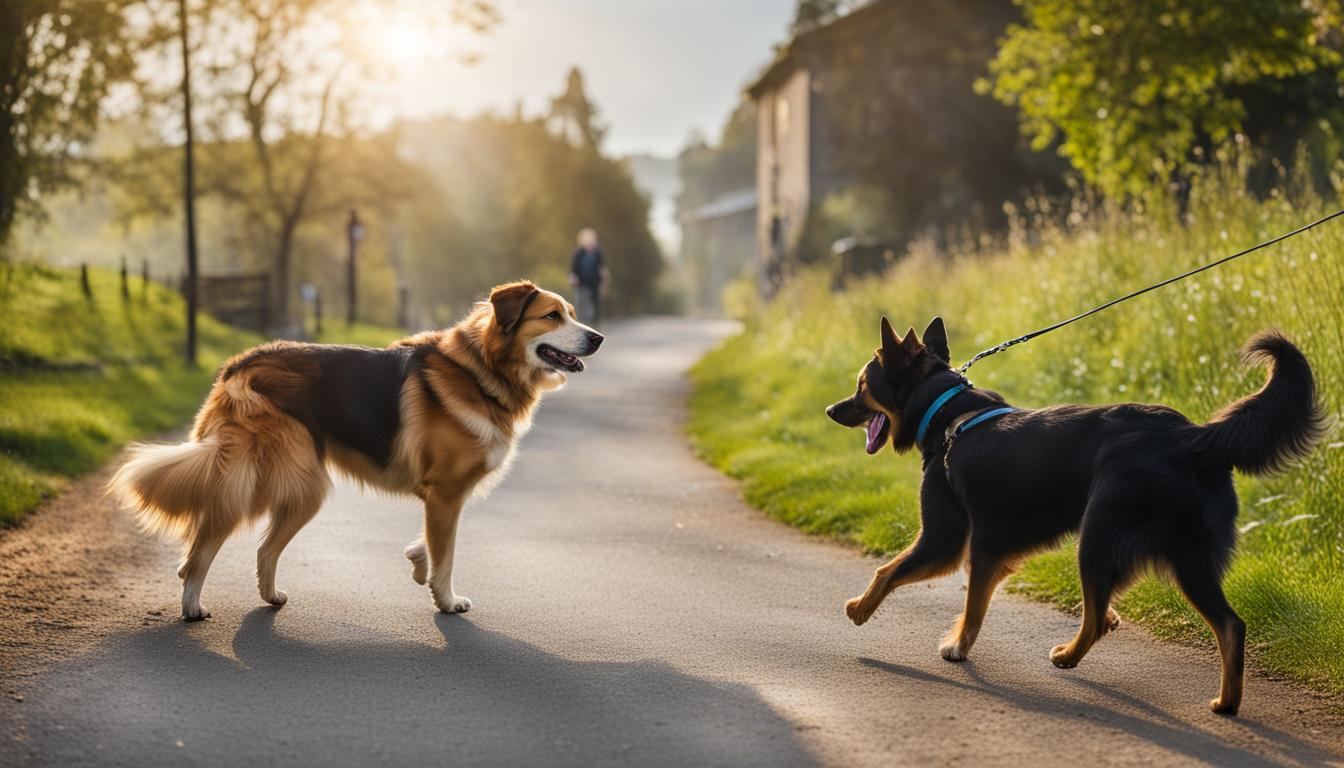Welcome to our comprehensive guide on understanding and managing predatory behavior in dogs. If you have a furry friend with hunting instincts, it’s important to equip yourself with the knowledge and strategies to ensure their safety and well-being. With the right approach, you can help your dog balance their natural instincts while curbing chasing behavior. Let’s dive in!
Key Takeaways:
- Predatory behavior in dogs follows a specific sequence triggered by environmental stimuli.
- Recognizing and understanding the stages of the predatory sequence is crucial for preventing behavior problems.
- Providing healthy outlets for a dog’s natural instincts, such as playing fetch, helps balance their prey drive.
- Training techniques focus on redirecting the dog’s behavior rather than suppressing their natural instincts.
- Working with a professional trainer or behaviorist can provide personalized strategies for managing predatory behavior.
The Predatory Sequence in Dogs: Unveiling the Hidden Behavior
In order to effectively manage and address predatory behavior in dogs, it is crucial to understand the hidden sequence of their predatory behavior. This natural behavior is triggered by specific stimuli in the dog’s environment, and it progresses through various stages, including scanning, chasing, biting, killing, and consuming. Each dog may have a different threshold and progression through these stages, making it important to tailor management strategies to individual dogs.
To better understand and address predatory behavior, it is essential to provide dogs with safe and controlled outlets for their natural instincts. This means allowing them to engage in the early stages of the predatory sequence, such as scanning and chasing, and then allowing them to disengage on their own terms. By doing so, we can help reduce their urge to run after and chase things over time.
Understanding prey drive in dogs is key to curbing predatory actions. It is important to note that our goal should not be to suppress a dog’s natural instincts entirely, but rather to redirect and manage them in a safe and controlled manner. By providing appropriate outlets for their energy, such as structured play sessions and mental stimulation, we can help dogs channel their prey drive in a more desirable way.

Table: Stages of the Predatory Sequence in Dogs
| Stage | Description |
|---|---|
| Scanning | The dog visually and audibly identifies potential prey. |
| Chasing | The dog begins pursuit of the prey, often triggered by movement. |
| Biting | The dog makes physical contact with the prey, using their teeth. |
| Killing | The dog dispatches the prey, often by shaking or biting vital areas. |
| Consuming | The dog consumes the prey, fulfilling their natural instincts. |
Addressing Predatory Aggression: Strategies for Management and Training
Predatory aggression in dogs can be a serious challenge for owners, as it involves aggressive behavior triggered by the desire to chase and catch prey. However, with the right strategies for management and training, it is possible to reduce and control this behavior. One effective approach is to focus on training for impulse control in dogs.
By teaching your dog to restrain their instinctual urges and respond to commands, you can help them learn to redirect their energy in a more appropriate and controlled manner. Training exercises that involve teaching your dog to wait, stay, and leave it can be particularly beneficial for impulse control.
In addition to impulse control training, providing alternative outlets for your dog’s natural hunting behavior can also help address predatory aggression. Puzzle toys or scent work activities, for example, can stimulate your dog’s mental and physical abilities while redirecting their energy away from aggressive behavior. It’s essential to find activities that engage your dog’s natural instincts and provide them with a fulfilling and safe way to express their predatory drive.
| Training Strategies for Reducing Predatory Aggression | Solutions for Natural Hunting Behavior |
|---|---|
| Impulse control training exercises | Puzzle toys for mental stimulation |
| Teaching “wait,” “stay,” and “leave it” commands | Scent work activities |
| Positive reinforcement techniques for desired behavior | Structured play to engage natural instincts |
Working with a professional dog trainer or behaviorist can provide valuable guidance and personalized strategies for managing predatory aggression in your individual dog. They can help you assess your dog’s specific triggers, develop a tailored training plan, and provide ongoing support throughout the process. With consistent training, patience, and the right tools, it is possible to address predatory aggression and create a safer and more harmonious relationship with your canine companion.
Understanding and Recognizing Different Types of Aggression in Dogs
Aggression is a complex behavior in dogs that can manifest in various forms and situations. By understanding and recognizing different types of aggression, we can develop effective strategies for managing and addressing this behavior. Let’s take a closer look at the various classifications of aggression in dogs:
Territorial Aggression
This type of aggression occurs when a dog perceives a threat to their territory, such as their home or yard. The dog may exhibit defensive behavior, barking, growling, or even attacking intruders. It’s important to establish clear boundaries and provide proper training to help dogs feel secure and confident within their territory.
Protective Aggression
Dogs may display protective aggression when they feel the need to defend their family members or resources. This can include behaviors like guarding food, toys, or people. Teaching dogs the concept of sharing and providing positive reinforcement for calm and non-aggressive behavior can help prevent and manage this type of aggression.
Possessive Aggression
Possessive aggression is similar to protective aggression but specifically pertains to a dog’s possessiveness over belongings. This can include growling, snapping, or biting when someone approaches their valued possessions. Implementing proper training and teaching dogs to relinquish items on command can be helpful in managing this type of aggression.
Fear Aggression
Fear aggression arises when a dog feels threatened or scared. It is a defensive response to perceived danger and can manifest in various ways, such as growling, barking, or lunging. Understanding the signs of fear in dogs and avoiding triggers that cause anxiety can help prevent fear-based aggression. Positive reinforcement training and desensitization techniques can also be beneficial in managing this behavior.
Defensive or Fear-Induced Aggression
Defensive aggression is similar to fear aggression and occurs when a dog feels cornered or trapped. The dog may lash out defensively to protect themselves. It’s crucial to create an environment that promotes a sense of safety and security for dogs, allowing them to feel more at ease and less likely to exhibit defensive aggression.
Social Aggression
Social aggression is directed towards other dogs or animals. It can occur due to various reasons, such as fear, lack of socialization, or resource guarding. Proper socialization, positive reinforcement training, and gradually exposing dogs to different social situations can help mitigate social aggression.
Understanding the different types of aggression in dogs is crucial for effective behavior management. By recognizing the underlying motivations and triggers, we can implement appropriate strategies that address and alleviate aggressive behavior in our canine companions.
Managing Aggression Stemming from Pain and Fear
Aggression in dogs can be triggered by various factors, including pain and fear. When a dog is in pain, they may exhibit aggressive behavior as a defense mechanism to protect themselves. It is crucial to address the underlying medical issues causing the pain and provide appropriate treatment to alleviate their discomfort. By addressing the root cause of the pain, we can often minimize or eliminate the aggressive behavior stemming from it.
Fear-motivated aggression, on the other hand, occurs when a dog perceives a threat and responds aggressively to protect themselves. Recognizing the signs of fear in dogs, such as trembling, panting, or cowering, is essential in preventing aggressive outbursts. Avoiding triggers that elicit fear reactions and gradually desensitizing the dog to these triggers through positive reinforcement training can be effective in managing fear-based aggression.
“Understanding that aggression in dogs can result from pain and fear is crucial in providing the right approach for managing and addressing their behavior. By addressing the underlying causes and providing a supportive environment, we can help our canine companions feel safe and secure, ultimately reducing their aggressive tendencies.”
It is important to note that managing aggression stemming from pain and fear requires a comprehensive and individualized approach. Working with a professional dog trainer or behaviorist can provide guidance and personalized strategies tailored to the specific needs of the dog. By addressing the underlying emotions and providing appropriate training and behavior modification techniques, we can help our dogs overcome their aggression and live happy, well-adjusted lives.
Table: Strategies for Managing Aggression Stemming from Pain and Fear
| Strategy | Description |
|---|---|
| Addressing pain | Identify and treat underlying medical issues causing pain, such as arthritis or injuries. Consult with a veterinarian for proper diagnosis and pain management. |
| Desensitization training | Gradually expose the dog to fear-inducing triggers in a controlled and positive environment, rewarding calm behavior and providing reassurance. |
| Positive reinforcement | Use reward-based training methods to reinforce desired behaviors, redirecting the dog’s focus away from aggression and towards more appropriate responses. |
| Professional guidance | Seek the help of a professional dog trainer or behaviorist who specializes in aggression and fear-related issues. They can provide personalized strategies and guidance based on the specific needs of the dog. |
Coping with Frustration-Related and Leash Aggression
Aggression in dogs can be a complex issue, and two common forms of aggression that owners often encounter are frustration-related aggression and leash aggression. These behaviors can be challenging to manage, but with the right strategies and training, you can help your dog overcome these issues and improve their behavior.
Understanding Frustration-Related Aggression
Frustration-related aggression typically occurs when a dog becomes easily frustrated in certain situations. This frustration can stem from a variety of factors, such as a lack of training or an inability to cope with specific triggers. When faced with frustration, dogs may exhibit aggressive behaviors as a way to communicate their dissatisfaction.
To address frustration-related aggression, it is crucial to retrain your dog and teach them alternative behaviors to express their frustration in a more appropriate manner. This can involve providing them with mental stimulation through puzzle toys or engaging them in structured play sessions that focus on impulse control. By redirecting their frustration into positive outlets, you can help reduce their aggression over time.
Coping with Leash Aggression
Leash aggression is another common issue that many dog owners face. Dogs may display aggressive behaviors when they are on a leash, feeling restrained or uncomfortable in certain social situations. This can be a result of fear, anxiety, or a lack of socialization.
To cope with leash aggression, it is essential to work on desensitization exercises and positive reinforcement training. Gradually exposing your dog to the triggers that cause their aggression, while rewarding calm and non-reactive behavior, can help them feel more confident and relaxed while on a leash. Seeking the guidance of a professional dog trainer or behaviorist may also be beneficial in developing a tailored plan to address your dog’s specific leash aggression issues.

| Signs of Frustration-Related Aggression: | Tips to Cope with Leash Aggression: |
|---|---|
|
|
Handling Possessive and Predatory Aggression
Possessive aggression is a common behavior in dogs, where they guard their belongings such as food, toys, or resting spots. To manage possessive aggression, it is important to establish boundaries and train the dog to share and relinquish items without displaying aggressive behavior. By teaching the dog commands like “leave it” or “drop it” and rewarding them for complying, you can promote positive behavior and reduce possessive tendencies.

Predatory aggression, on the other hand, is driven by a dog’s natural instincts to chase and catch prey. This behavior can be redirected by providing appropriate outlets for these instincts. Structured play sessions and mental stimulation activities, such as puzzle toys or scent work, can help satisfy their predatory drive in a controlled and safe manner. Engaging your dog in these activities not only redirects their energy but also strengthens the bond between you and your furry friend.
Training Techniques for Possessive Aggression:
- Start by creating a safe and calm environment during feeding or playtime.
- Gradually introduce the concept of sharing and trade-up, rewarding the dog for letting go of an item or allowing you to handle it.
- Use positive reinforcement techniques such as treats or praise to reinforce good behavior.
- Seek professional guidance from a dog trainer or behaviorist for more complex cases of possessive aggression.
Redirecting Predatory Aggression:
- Engage your dog in interactive play sessions using toys specifically designed for fetch or tug-of-war.
- Provide mental stimulation through puzzle toys or scent work, allowing your dog to use their natural hunting instincts.
- Practice recall exercises in a controlled environment to reinforce obedience and redirect their chase drive.
- Supervise outdoor activities and always keep your dog on a leash or in a secure, fenced area to prevent chasing behavior.
| Possessive Aggression | Predatory Aggression |
|---|---|
| Guarding behavior | Chasing and pouncing on perceived prey |
| Protecting food, toys, or resting spots | Instinctual response triggered by specific sights, sounds, or smells |
| Can be triggered by resource scarcity or previous negative experiences | Can vary from dog to dog in terms of thresholds and triggers |
| Training techniques focus on boundary-setting, sharing, and trade-up | Training techniques involve redirecting predatory instincts through games and mental stimulation |
Conclusion
As a responsible dog owner, it’s important to understand and address aggressive behavior in your furry friend. By implementing effective solutions for aggressive dog behavior, you can create a safer and happier environment for both you and your canine companion.
When it comes to managing predatory behavior, providing healthy outlets for your dog’s natural instincts is key. Engage them in structured play and mental stimulation to redirect their energy. This not only helps balance their prey drive but also reduces the risk of aggressive behavior.
Training strategies play a vital role in addressing both predatory and aggressive behavior. Seek professional help if needed to develop personalized training plans that address your dog’s specific needs. Remember, patience and consistency are key to successful training.
By understanding your dog’s individual needs and implementing the right training strategies, you can effectively manage and address aggressive behavior. With dedication and love, you can help your furry friend thrive and create a harmonious bond that lasts a lifetime.
FAQ
What is predatory behavior in dogs?
Predatory behavior in dogs refers to the instinctual sequence of actions triggered by specific stimuli in their environment, including scanning, chasing, biting, killing, and consuming.
Why is it important to understand the predatory sequence in dogs?
Understanding the predatory sequence in dogs is crucial for effectively managing and addressing this instinctual behavior, preventing behavior problems, and creating safe engagement and training techniques.
How can I provide healthy outlets for my dog’s natural instincts?
Providing activities like playing fetch or engaging in structured play can help balance your dog’s prey drive, redirect their energy, and ensure their safety.
What are the different types of aggression in dogs?
The different types of aggression in dogs include territorial aggression, protective aggression, possessive aggression, fear aggression, defensive aggression, and social aggression.
How can I manage predatory aggression in my dog?
Managing predatory aggression in dogs involves strategies such as impulse control training, providing alternative outlets for hunting behavior, and working with a professional trainer or behaviorist for personalized guidance.
What can trigger aggressive behavior in dogs?
Aggressive behavior in dogs can be triggered by factors such as pain, fear, frustration, or feeling restrained on a leash.
How can I address aggression stemming from pain or fear?
Addressing aggression stemming from pain or fear involves identifying and treating any underlying medical issues causing pain and using positive reinforcement training and desensitization techniques to manage fear-based aggression.
How can I cope with frustration-related and leash aggression in my dog?
Coping with frustration-related aggression can involve retraining and teaching alternative behaviors, while managing leash aggression may require training and desensitization exercises to help dogs feel more confident and relaxed.
How can I handle possessive and predatory aggression in my dog?
Handling possessive aggression involves training, setting boundaries, and teaching the dog to share without aggression. Addressing predatory aggression can be done by providing appropriate outlets for the dog’s natural instincts and redirecting their energy.
What are effective training strategies for managing predatory behavior in dogs?
Effective training strategies for managing predatory behavior include understanding the stages of the predatory sequence, providing healthy outlets for natural instincts, and seeking professional help when necessary.





